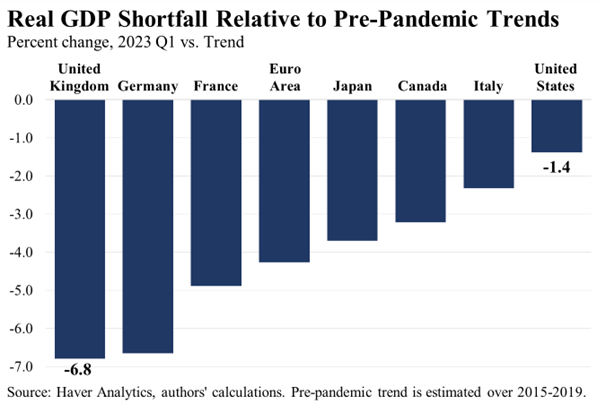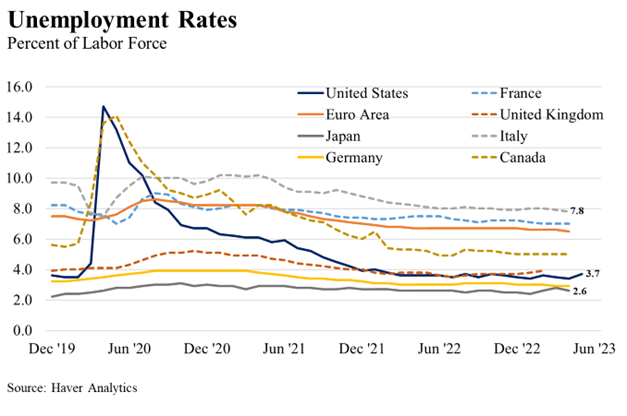By: Assistant Secretary for Economic Policy Benjamin Harris and Deputy Assistant Secretary for Macroeconomic Policy Tara Sinclair
Preview
With the second anniversary of the American Rescue Plan now behind us, this blog post looks back at the economic impact of the Biden administration’s pandemic response policies. The post-pandemic economic recovery in the United States has been historic compared to previous episodes, with employment returning to pre-crisis levels much faster than after recent recessions. And although it is impossible to observe a counterfactual recovery, the data suggests that the actions taken by the Biden administration have contributed significantly to the pace of the recovery and the strength of the labor market. A way of put that bounce the context relates to the recovery in other advanced economies. Recognizing that other advanced economies have faced different economic shocks (notably our European partners were hit harder by Russia’s war against Ukraine), the evidence shows that the U.S. economic recovery was quite strong.
This blog assesses the US recovery according to three key characteristics:
- The size of the U.S. economy is now more than 5% larger than in 2019.
- Core inflation in the United States is now lower than in many major advanced economies
- The recovery in the US labor market has been exceptionally strong
This is not to say that the current recovery is without challenges. Short-term inflation remains a concern, and long-term structural challenges remain. Yet many aspects of the U.S. recovery point to a stronger recovery in the United States than in other economies.
U.S. economic recovery fastest among comparable advanced economies

For many advanced economies, real GDP is at or above that of the fourth quarter of 2019, before the pandemic began. However, there is considerable variability between countries. Not all G7 economies have fully returned to their pre-pandemic size; on the other hand, American real GDP is now 5.4% higher than its level at the end of 2019.
Compared to pre-pandemic trends, economic output remains insufficient. However, the United States performed better than other G7 economies (and the Eurozone), with real GDP just 1.4% below trend.
The rapid recovery in the United States reflects a more complete recovery in domestic consumption. In fact, U.S. household consumption spending returned to its pre-pandemic trend in the second quarter of 2021. However, household consumption remains below the pre-pandemic trend in most other advanced economies, with the recovery of the final application remaining incomplete.
Despite higher growth, underlying inflation in the United States is now lower than in many other major advanced economies

Faster output growth in the United States was initially accompanied by higher inflation, but inflation rates rose rapidly around the world. In Europe, inflation rates rose rapidly in 2022 due to the combination of high natural gas prices and the restart of the European economy after strict Covid restrictions during the Delta and Omicron waves. Conversely, over the course of 2022, inflation in the United States improved significantly, while inflation rates in Europe continued to rise. Of course, energy prices in Europe have been particularly hard hit by Russia’s illegal invasion of Ukraine. Excluding energy and food, core inflation rates (on a harmonized basis) are below 4% in the United States, while they are close to 6% in the United Kingdom and above 7% in the region. euro.(1)
The recovery in the US labor market has been exceptionally strong

Employment statistics appear to show striking differences between G7 economies in the Covid era. For example, U.S. and Canadian unemployment rates soared in April and May 2020 – up 11.1 and 8.5 percentage points, respectively, from December 2019 – while many unemployment rates Unemployment in Europe remained relatively stable. In fact, in France and Italy, unemployment rates fell significantly during the first months of the pandemic.
Despite first impressions, this does not reflect a significant divergence in labor activity. Rather, these trends reflect differences between national labor institutions. Each government used its existing institutions to support workers and businesses during the initial Covid shutdown. In the United States and Canada, unemployment insurance was best suited for rapid, large-scale support. Many European economies have also tapped into their social safety nets, often in ways that have led to employment remaining in official statistics – like the little-used Workshare program in the United States. The broader and stronger fiscal response has resulted in generally higher U.S. government deficits during the pandemic. However, deficits contracted quickly with pandemic support largely ending in the third quarter of 2021. At the end of 2022, the United States had a similar budget deficit as a share of GDP as peer countries.
Official statistics from most other G7 economies show neither a sharp rise in the unemployment rate in spring 2020 nor a corresponding robust recovery. Again, this is partly due to different labor market institutions and policies adopted during the pandemic era, rather than a reflection of underlying differences in labor activity. In January, the unemployment rate in the United States reached its lowest level in more than 50 years. Germany has seen similar lows, while Canada and the United Kingdom are also near their lowest.
The similar labor market recovery, despite disparate production recoveries, has implications for labor productivity. Labor productivity growth in the United States has outpaced that of Europe and Japan. Here, labor market policies can play a role. The American system relies mainly on unemployment insurance, which could have allowed greater reallocation of work compared to systems that preserved employer attachment. Generally speaking, employment in the United States has been reallocated from low-wage sectors to higher-wage, higher-productivity sectors. U.S. employment has also shifted to sectors with higher average hours worked, implying a stronger recovery in hours relative to employment. This reallocation of labor could lead to further gains in labor productivity in the future.
(1) Harmonized inflation ensures comparability between inflation measures in the United States and Europe; The harmonized inflation rate in the United States is produced by the Bureau of Labor Statistics. Harmonized inflation is not available for the United Kingdom, Canada and Japan; core CPI inflation shown for these countries.

